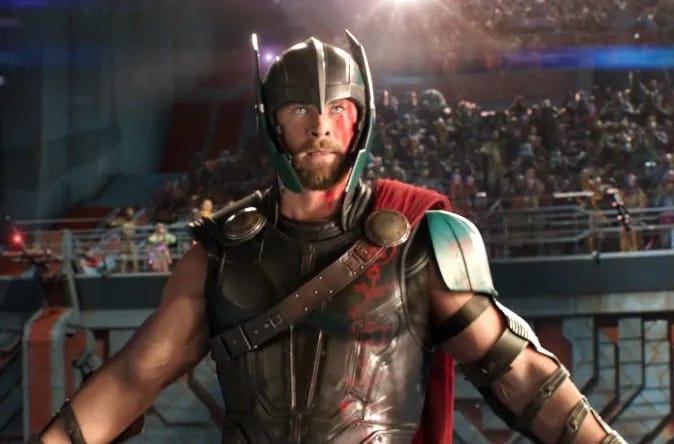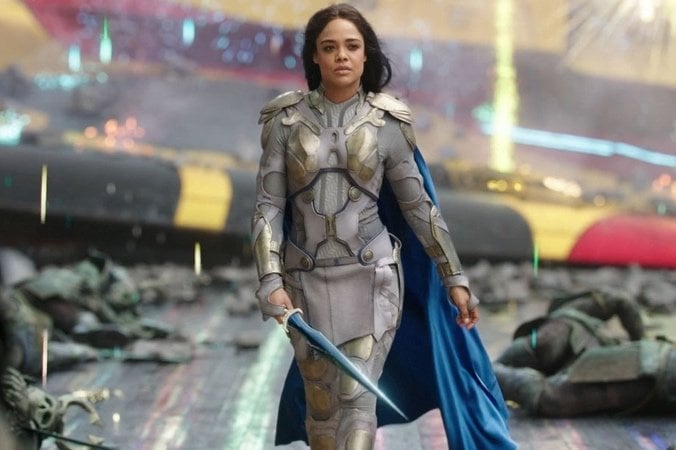
A cheeky comedy with an uncharacteristic ending, 2017’s Thor: Ragnarok was not the film fans expected to completely overturn the Thor franchise, much less the entire Marvel Cinematic Universe. But now that Thor: Love and Thunder has come to theaters and Disney+, it’s clear that director Taika Waititi and his team meant to shake up the Marvel tradition from the start.
“‘We’re a bit tired of, um, you know, this fish-out-of-water thing with Thor on Earth,’” Waititi told Den of Geek in 2017, quoting Marvel’s initial discussions of the plan for Thor’s third installment. “Because there’s only so much of that you can deal with…we’ve seen that before, many times before. So why not go towards the direction of the comic books from the seventies and eighties and have Thor on a cosmic adventure?”
Ragnarok’s expansion of the Marvel cosmos happens in more ways than just one. In Thor (2011) and Thor: The Dark World (2013) Thor’s confident obliviousness was used mostly for dropping points of levity into a darker, more traditionally serious filmscape. But Waititi realized there was more potential to Thor’s character than it seemed. By tapping more into these comedic aspects while setting the movie’s tone, the director was able to saturate Ragnarok with a contagiously fun energy that received widespread critical praise. But he also took things one step further in using this lighter tone as a back door to explore heavier — and more interesting — concepts.
Waititi mused to Screen Rant shortly before Ragnarok’s release that Thor was “a lot grubbier” in the film than in past incarnations.
“You know, I love heroes that really go through ordeals, and they come out the other end completely changed…We do a lot to this character in this film.”
It’s no mistake that Thor’s most treasured possession — his hammer — is destroyed by his villainous sister Hela within the first twenty-five minutes of the movie. And as the hero embarks on a multidimensional quest to prevent the Norse apocalypse “Ragnarok,” he finds himself stranded on a literal garbage planet where his privilege is no longer instantly recognized.
Based on the Norse god of Thunder, the MCU’s Thor in many ways represented the archetype for white masculinity. But set against the multiracial Asgard and in the hands of Marvel’s first director of color, the character became almost a deconstruction of Marvel’s customary white-male superhero.

The swashbuckling Valkyrie (Tessa Thompson) returns to Asgard to take it back.
“A lot of people are excited by the idea of what ‘Ragnarok’ means.” Waititi continued to Screen Rant. “But to me, it means stripping down the establishment of what’s already there, and then building it up in a new way.”
Just as Thor ultimately realizes he does not have to rely on the power he took for granted his entire life, Waititi seemed to realize the radical direction in which he had steered Marvel, noting that “in a way, you can never go back from that.”
Nowhere is Ragnarok’s changing tide more evident than in Tessa Thompson’s swaggery, scene-stealing ex-warrior Valkyrie. One of the MCU’s first Black female leads, Thompson took a delight in playing the film’s “Han Solo”, an uncharacteristic role for the typical woman in a Marvel film. And while it’s never explicitly mentioned, Thompson thought of Valkyrie as bisexual, drawing on her character from the original comics.
“There’s a great shot of me falling back from one of my sisters who’s just been slain,” Thompson said to Rolling Stone, recounting the film’s flashback to Hela’s murder of Valkyrie’s warrior clan. “In my mind, that was my lover.”
When Valkyrie joins Thor and Bruce Banner to save Asgard in the film’s climax, it may have been the first time that many audience members got to see themselves on-screen for such a moment.
“The truth is [Marvel] movies travel globally in such huge ways,” Thompson later expressed to Variety. “And if you can represent people that are of color, if you can represent people with disabilities, if you can represent the LGBTQIA community inside of these films, it’s a pretty big deal.”
With Waititi’s help, Ragnarok became an expansion of not just what the Marvel cosmos could be, but who.
Thor ultimately finishes his journey by allowing Ragnarok to destroy his beloved Asgard, taking it out of Hela’s clutches. This was a choice that could have felt jarring in any other director’s hands. But Waititi smoothly pilots Ragnarok to its conclusion by subtly building to it throughout the entire film.
As Cate Blanchett’s Hela commences her takeover of Thor’s home world, she stunned audiences by revealing how Asgard’s status was really won: through bloodshed and conquest. “Where do you think all this gold came from?” she tauntingly sneers at Thor during their final battle, standing in the halls that she and Odin had built on subjugation.
Ragnarok is undeniably a superhero comedy. But as we watch Hela destroy old Asgardian art works to reveal the violent histories behind them, we can’t help but think of colonization, and all the ways that our own histories are shaped by it. In turning this kind of narrative around onto traditionally white characters from Norse mythologies, Waititi’s Marvel debut completely flips the script. And by weaving this real-world conflict into a story of demigods and aliens, Waititi not only demonstrated his abilities as a storyteller: He also consciously pushed the boundaries of the kinds of topics that Disney and Marvel Studios could broach.
Perhaps in part because of his own Indigenous identity, Taika Waititi was able to stick Ragnarok’s ambitious landing. “Asgard is not a place,” guardian-god Heimdall reassures Thor as they watch their home crumble from afar. “It’s a people.” Just as Thor chose to leave Asgard behind, so did Waititi purposely stray from the ways Marvel had always done things. Pairing a glib irreverence with a surprising depth, Thor: Ragnarok paved a surprisingly progressive path for Marvel to follow.
Thor: Love and Thunder is now streaming on Disney+.

